Rhubarb is a versatile vegetable that offers a unique tart flavor to a variety of dishes. It derives from the Polygonaceae family and appears most commonly in its crimson red stalks, although it can also be found in green and speckled pink varieties.
The taste of rhubarb can be quite astringent when raw, which is why it’s frequently sweetened and cooked. It is an ingredient heralded for its compatibility with strawberries and use in delectable pies, but its utility extends well beyond that.
Cooking rhubarb involves selecting firm, crisp stalks and storing them properly to maintain freshness.
Prior to cooking, it must be prepared correctly, usually involving trimming and discarding the leaves, which are toxic if consumed.
An array of methods can be employed to cook rhubarb, from stewing to roasting. Each method enhances its distinctive tartness while allowing it to absorb other flavors effectively. The high level of acidity in rhubarb complements sweet and savory dishes alike, transforming them into complex, flavorful creations.
Key Takeaways
- Rhubarb’s tangy taste is best subdued with sweetening and is a staple in desserts.
- Proper selection and storage extend its shelf life and quality for cooking.
- It is important to prepare rhubarb properly, as the leaves are inedible and toxic.
Rhubarb Basics
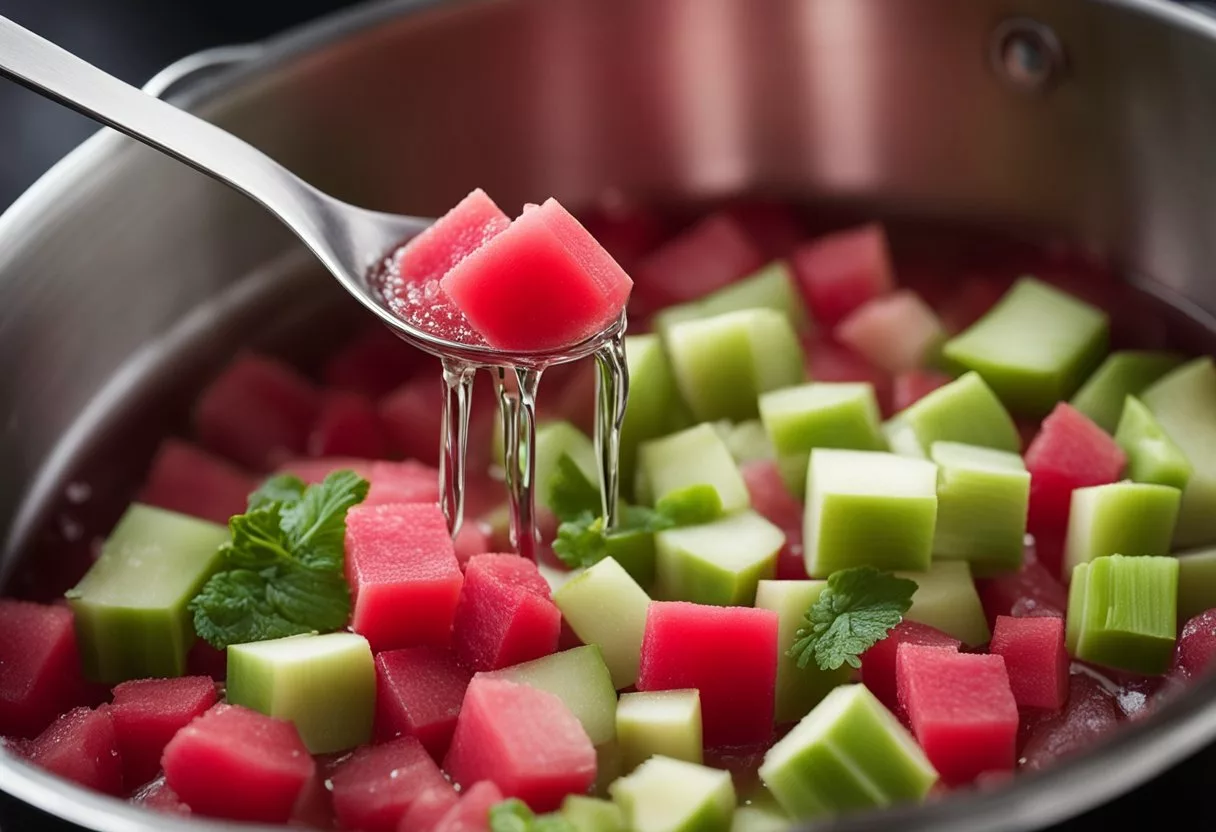
When handling fresh rhubarb, one must remember that while the stalks are a culinary delight, especially in spring, rhubarb leaves are poisonous and should never be consumed.
To prep rhubarb, start by trimming off the leafy part and the base of the stalk, as they are not edible.
Preparation Steps:
- Washing: Thoroughly rinse the stalks to remove any dirt.
- Trimming: Cut off and discard the leaves and ends.
- Peeling: Generally, there’s no need to peel rhubarb unless the outer layer is particularly tough or stringy.
| Preparation | Description |
|---|---|
| Washing | Rinse under cold water to clean. |
| Trimming | Remove leaves and ends. |
| Peeling | Optional, based on the stalk’s toughness. |
Rhubarb’s tartness is a fine complement to sweet dishes and is traditionally used in desserts.
Remember to cut rhubarb into pieces of a consistent size to ensure even cooking.
When cooking rhubarb, one might add sugar to balance its natural tartness; how much sugar to add depends on personal taste and the recipe being prepared.
One common method of preparation is to stew rhubarb, which entails cooking the cut pieces with sugar and a bit of water.
This method softens the rhubarb, creating a compote-like texture perfect for pairing with desserts or oatmeal.
Proper preparation of rhubarb allows one to harness its unique flavor profile, enhancing a variety of recipes from savory to sweet. Always handle rhubarb with care and respect its characteristics for the best culinary results.
Choosing and Storing Rhubarb
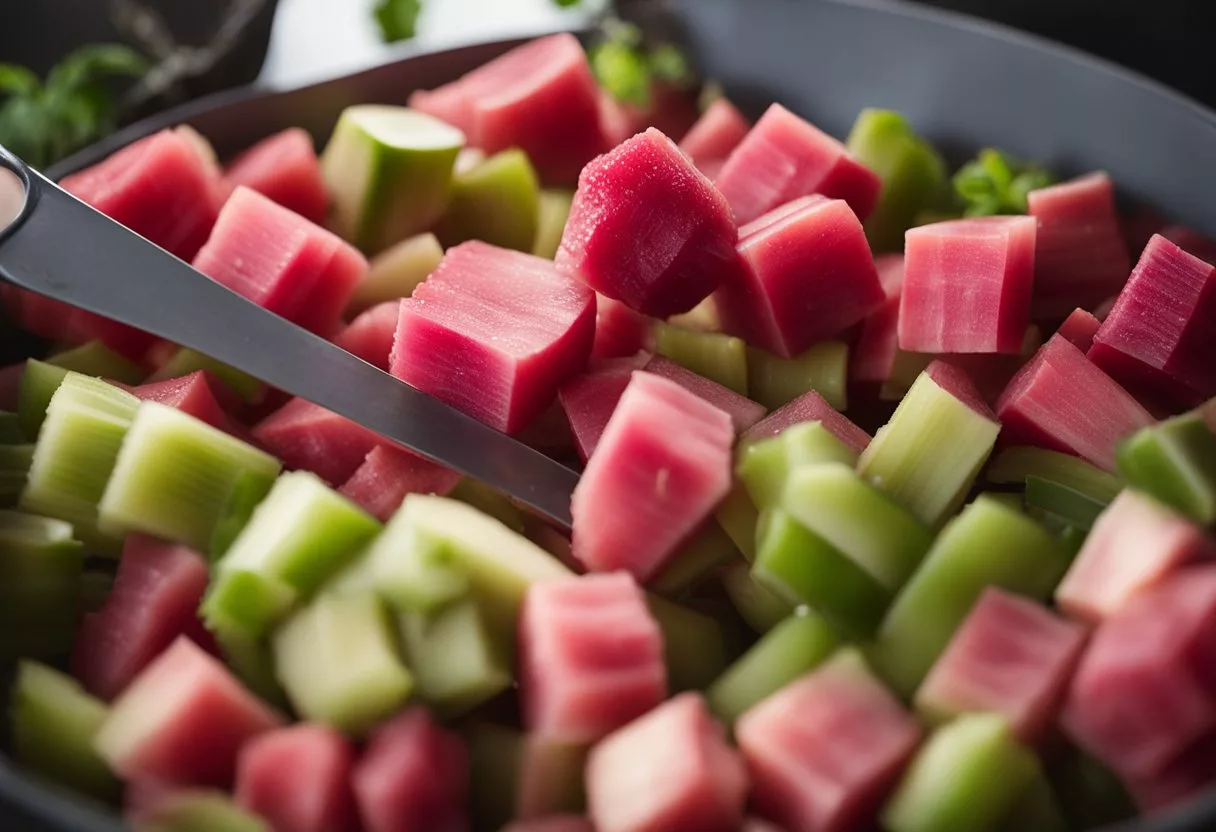
When it comes to rhubarb, one must ensure they’re selecting the freshest stalks and using effective storage techniques to maintain its quality. Optimal freshness can lead to better taste and longevity of the rhubarb.
Selecting Quality Stalks
To select the highest quality rhubarb, one should look for firm, crisp stalks boasting a bright, vibrant color. The presence of fresh-looking, unwilted leaves is also a good indicator of quality. One should avoid stalks that are limp or have blemishes.
Storage Techniques
To retain the freshness of rhubarb, appropriate storage methods are key:
- In the Refrigerator: Wrap rhubarb stalks in a damp paper towel and place them inside an airtight container or a resealable plastic bag. This method will keep rhubarb fresh for up to a couple of weeks.
- In the Freezer: For long-term storage, rhubarb can be frozen. One should first wash, dry, and cut the stalks into bite-sized pieces. Blanche the pieces and cool them promptly in ice water before spreading them out on a baking sheet to freeze individually. Once frozen, transfer the rhubarb into freezer bags.
It is imperative to note that when using rhubarb after freezing, one may expect some textural changes. Frozen rhubarb is best used in cooked preparations.
Preparation Methods
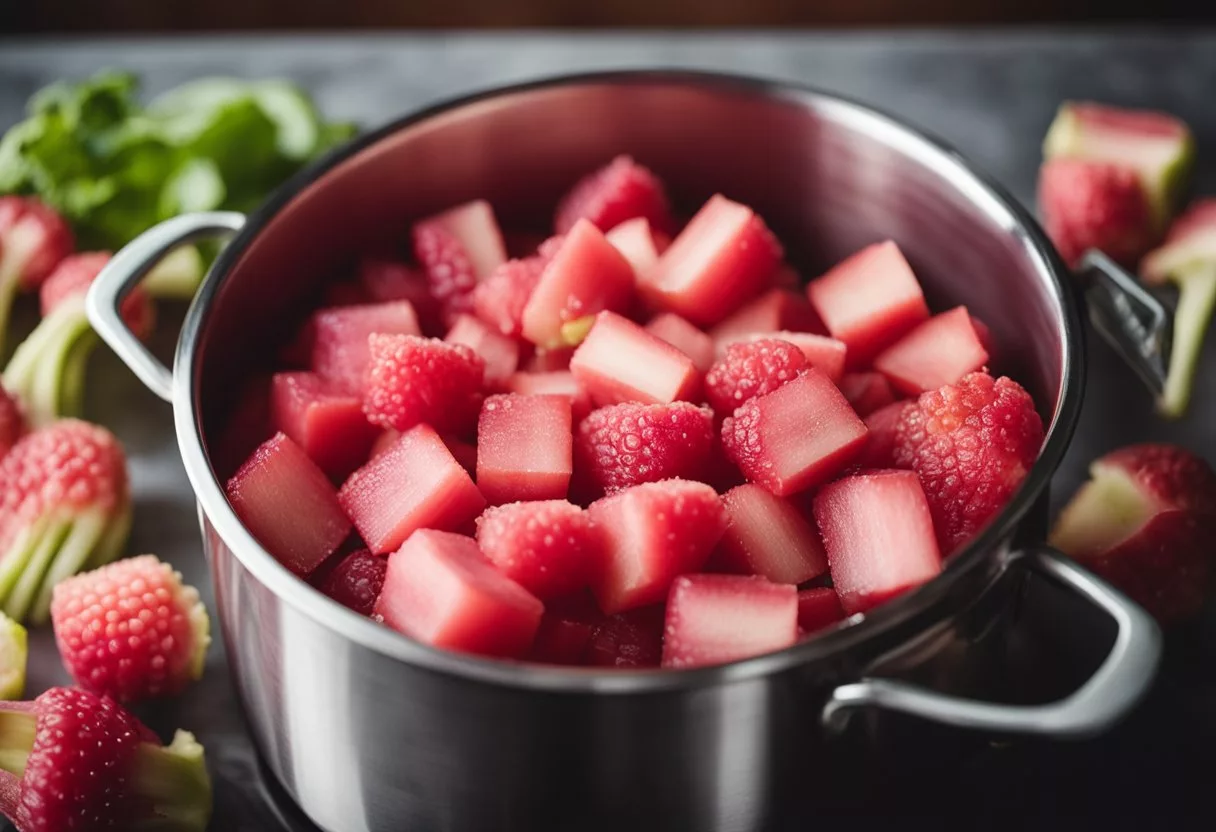
The process of preparing rhubarb for cooking involves meticulous cleaning and precise cutting. Adhering to these methods ensures the rhubarb is safe and palatable for a variety of dishes.
Cleaning and Trimming
The first step in preparing rhubarb is to thoroughly wash the stalks to remove any dirt or debris.
Then, one must trim off the leaves, which are toxic and should never be consumed.
A cutting board provides a stable surface for trimming the ends of the stalks, which are often tough and not ideal for eating.
Cutting Techniques
After cleaning, cutting the stalks into smaller pieces is essential for even cooking.
Uniform pieces ensure each bite is tender and properly cooked.
A sharp knife is important for cutting, and the pieces should typically be about 1-inch in length.
For recipes requiring finer texture or when a fork is used as an eating utensil, smaller, bite-sized pieces may be preferable.
Cooking Techniques
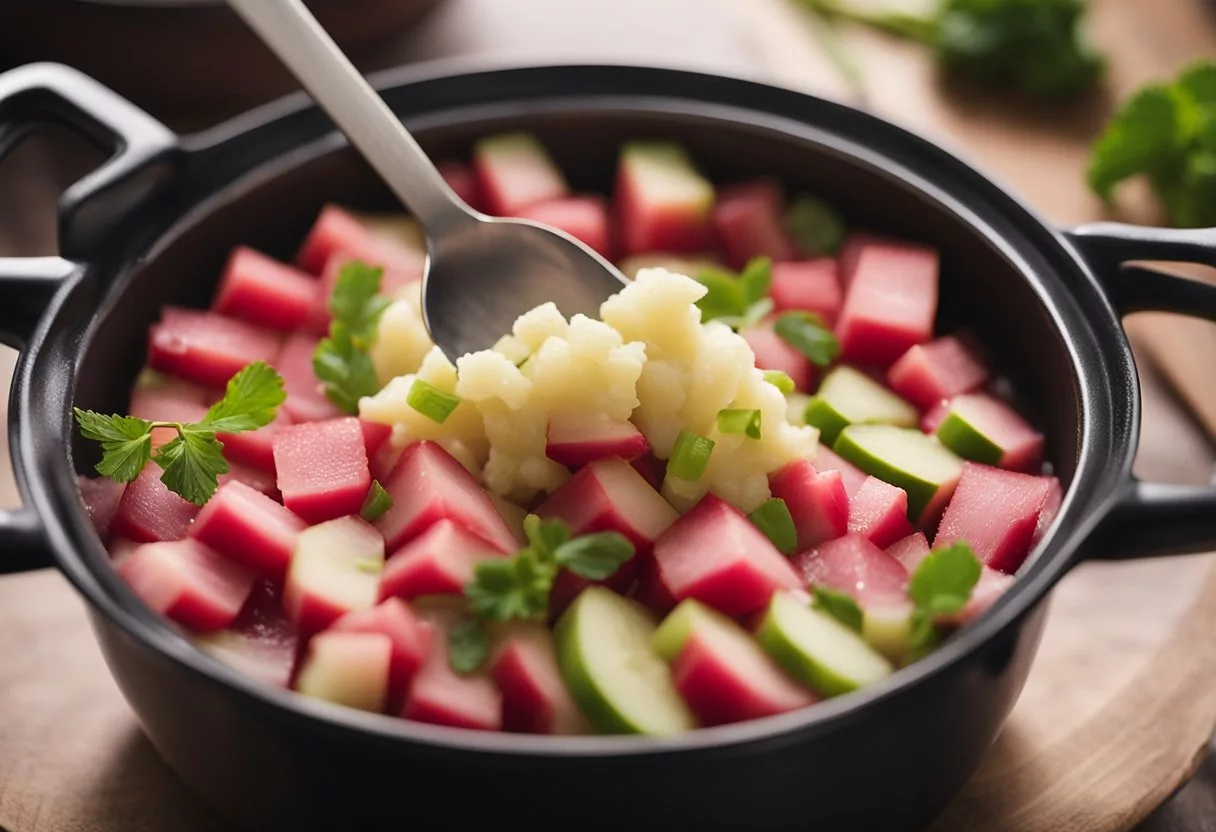
Exploring different cooking techniques allows one to unlock the full potential of rhubarb’s tart flavor. Each method can yield a distinctive texture and taste, ideal for various recipes.
Baking Rhubarb
When one bakes rhubarb, it’s important to use a baking dish that allows for even heat distribution.
The process typically involves chopping rhubarb into equal-sized pieces, adding sugar, and baking in a preheated oven at a moderate temperature until it’s tender but still holds its shape. This can be used in pies or crumbles.
Stewing Rhubarb
To stew rhubarb, one must cut the stalks into chunks and simmer them in a small amount of water and sugar until they break down into a soft consistency.
This technique is great for creating compotes or fillings that one can serve with desserts or as a tangy sauce for savory dishes.
Roasting Rhubarb
Roasting rhubarb intensifies its flavor through caramelization.
By arranging rhubarb in a single layer in a baking dish and cooking at a high temperature, the stalks become tender and develop a deeper sweetness.
This preparation can elevate a simple recipe to new heights and is often enjoyed as a dessert topping.
Rhubarb Recipes and Pairings
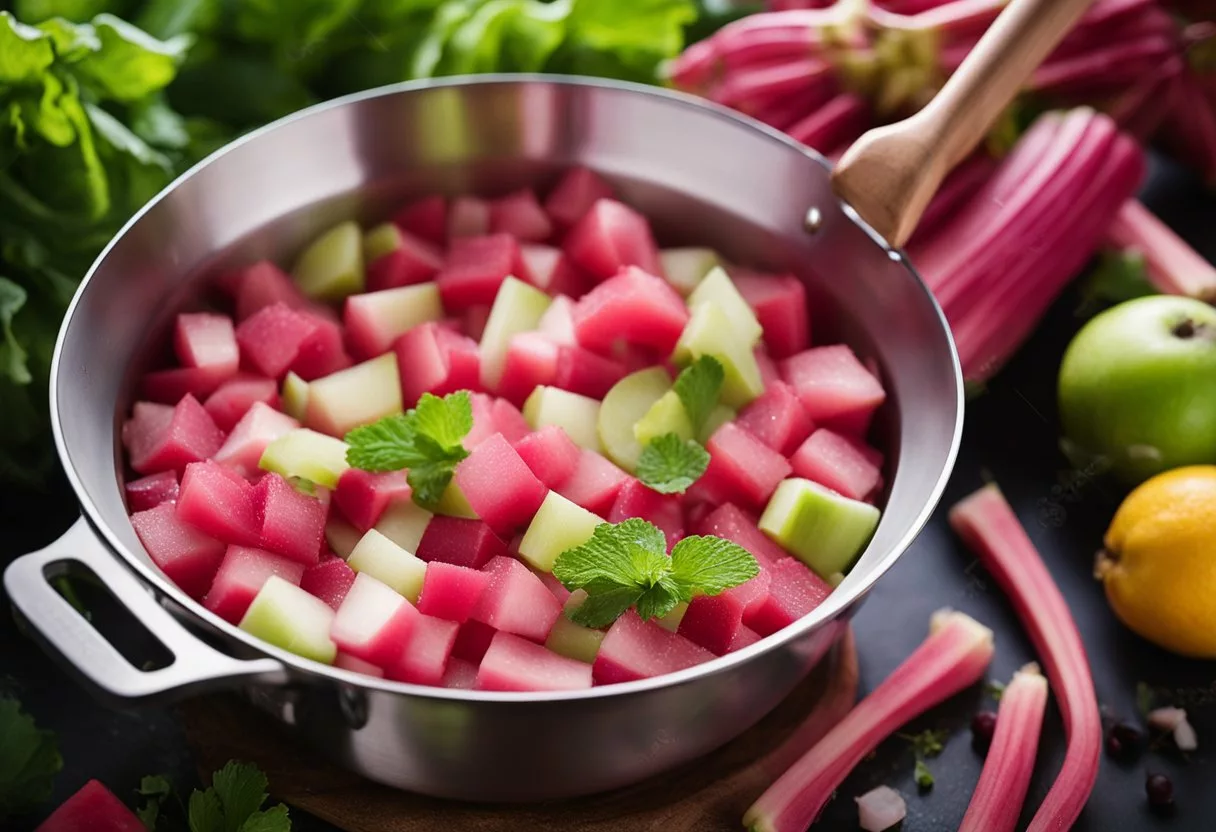
Rhubarb, with its tart and fruity quality, serves as a versatile ingredient in various culinary delights, pairing exceptionally well with pork and citrus flavors. Its natural astringency complements both savory dishes and sweet confections, making it a springtime favorite.
Rhubarb Pies and Tarts
One of the most classic uses for rhubarb is in pies and tarts.
To achieve a rhubarb pie that balances tartness and sweetness, one can mix chopped rhubarb with sugar and a hint of orange zest before encasing it in a flaky pie crust.
For tarts, arranging thin rhubarb slices atop pastry cream in a prebaked tart shell can yield a visually stunning dessert.
Example Rhubarb Tart:
- Filling: Rhubarb, finely sliced; Sugar; Lemon juice
- Crust: Flour; Butter; Icing sugar
- Glaze: Apricot preserves; Water
Rhubarb Compotes and Chutneys
Rhubarb’s ability to transform into a succulent compote makes it a great companion to meats, such as pork.
They can braise pork chops in a sauce made with tangy rhubarb for a savory twist.
Alternatively, a rhubarb chutney with hints of ginger can serve as a charming condiment.
Ingredients for Rhubarb Chutney:
- Rhubarb, chopped
- Red onions, finely diced
- Vinegar
- Brown sugar
- Raisins
Rhubarb Desserts
In the realm of desserts, rhubarb can be fashioned into various forms such as crisps, crumbles, and cobblers.
A rhubarb crisp combines the fruit with a streusel topping, usually containing oats, creating a crunchy texture contrast.
For a comfort dessert, a rhubarb crumble offers a warm and spiced interpretation, marrying particularly well with vanilla ice cream.
How to Make Rhubarb Crisp:
- Layer rhubarb: Chopped rhubarb in a baking dish; Sprinkle sugar and a touch of flour.
- Create topping: Mix together flour, brown sugar, oats, and a pinch of cinnamon. Cut in butter until crumbly.
- Bake: Until the topping is golden and the rhubarb is bubbling.
Ingredients and Flavorings

When cooking rhubarb, careful selection of complementary ingredients and flavorings is crucial to enhance its unique tartness. Sweeteners will balance the astringency, while spices and seasonings contribute nuanced flavors.
Sweeteners
- Sugar: A traditional choice, sugar neutralizes rhubarb’s sharpness and is often used in a 1:2 ratio of sugar to rhubarb.
- Honey: It imparts a floral note that pairs well with the vegetable’s tang. Use honey sparingly as it is sweeter than sugar.
- Maple Syrup: This adds a rich, earthy sweetness and can serve as a substitute for sugar in baking and sauces.
- Agave Syrup: A vegan alternative with a mild taste, it is suitable for sweetening rhubarb dishes without overpowering them.
Spices and Seasonings
- Cinnamon: A sprinkle of cinnamon can create a warm and comforting flavor profile when added to rhubarb recipes.
- Ginger: Fresh or ground ginger adds a zesty kick, which complements the tartness of rhubarb, particularly in pies and compotes.
- Vanilla: Incorporating vanilla into rhubarb dishes brings a subtle sweetness and complexity, enhancing desserts especially well.
- Nutmeg and Cardamom: These spices contribute an aromatic warmth with undertones that are particularly delightful in baked goods.
- Salt: Just a pinch can intensify the natural flavors of rhubarb and the accompanying sweeteners and spices.
- Citrus Zest: Lemon or orange zest can add a refreshing brightness and elevate the overall taste of a rhubarb dish.
- Berries: Strawberries are often paired with rhubarb for their complimentary sweetness and color contrast, resulting in a balanced and vibrant dessert.
Rhubarb in Baking
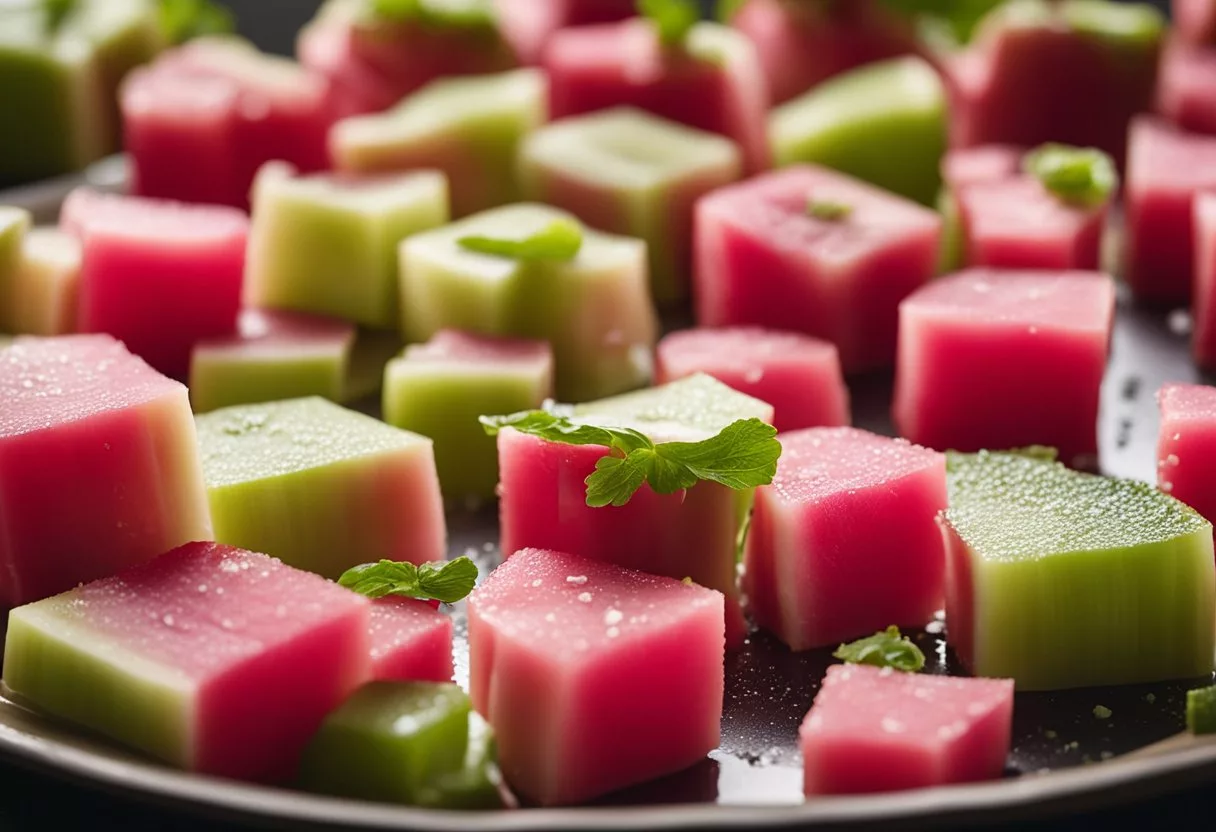
Rhubarb offers a tart contrast in sweet baked goods, transforming them with its unique flavor profile. When baking with rhubarb, one must consider the balance of sweetness and tartness as well as the texture it contributes to the final product.
Pastries and Cakes
In pastries and cakes, rhubarb can be incorporated either as a layer or mixed into the batter.
A classic example is rhubarb upside-down cake, where rhubarb pieces are placed at the bottom of the pan, covered in sugar and butter, and then topped with cake batter. As it bakes, the rhubarb softens, and the sugars caramelize, providing a flavorful foundation to a moist and fluffy cake.
For cheesecake, incorporating rhubarb into the filling or using it as a compote on top adds a tangy dimension that cuts through the richness of the cream cheese. The key in these applications is to adequately sweeten the rhubarb to preserve its distinct tartness while achieving the desired sweetness of the dessert.
Homemade Breads
Rhubarb can be a surprising addition to homemade breads, such as muffins or quick breads.
By folding diced rhubarb into the batter, along with complementary spices like cinnamon or vanilla, one imparts pockets of tartness into each bite, which enlivens the overall flavor.
Using rhubarb in pancakes or waffles provides a seasonal touch to breakfast classics.
It’s recommended to finely chop the rhubarb and mix it into the batter so that it cooks quickly and evenly. This can be complemented by a rhubarb-infused syrup or a dollop of rhubarb compote atop the fluffy stack.
In each application, the rhubarb should be prepared properly, remembering to trim off the leaves and dice the stalks before incorporating them into your recipes.
For breads, a mixture of rhubarb with a bit of sugar can ensure that the moisture and tartness are distributed throughout the loaf without overpowering it.
Rhubarb as a Condiment
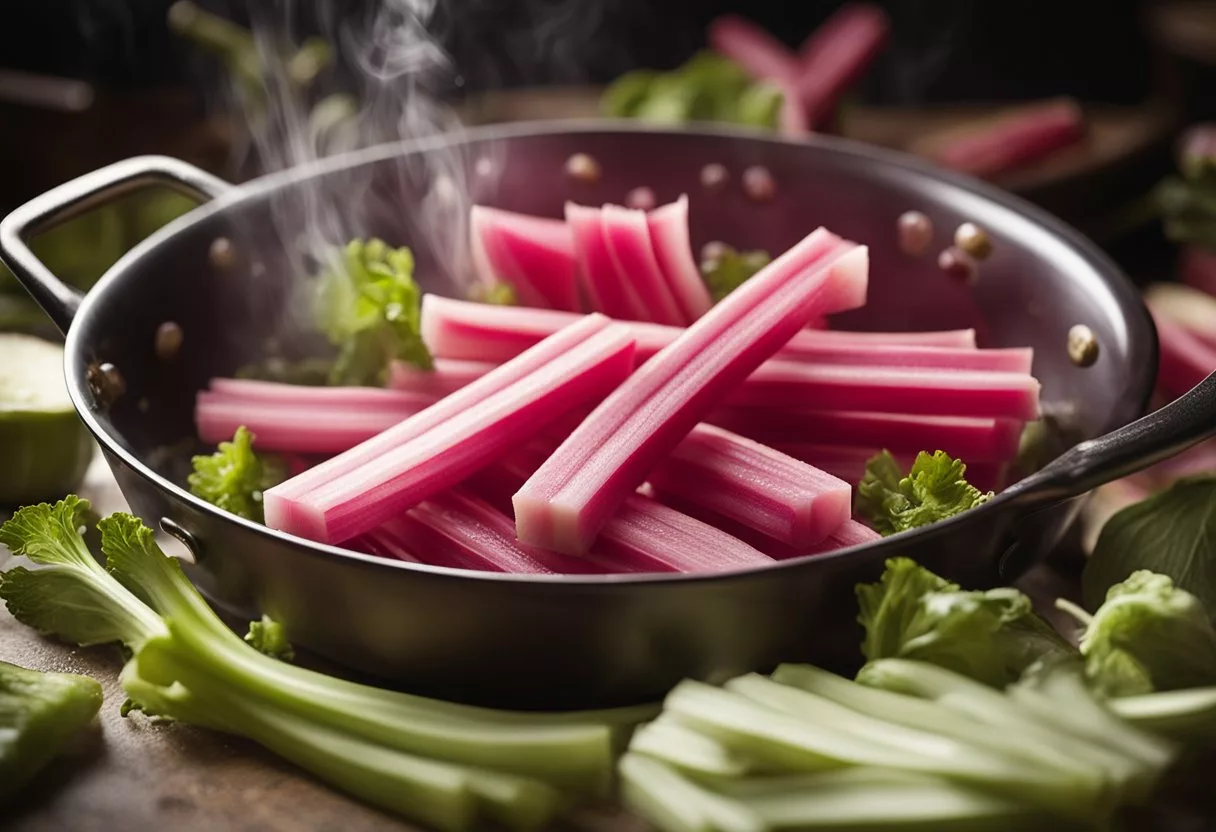
Rhubarb is traditionally known for its tartness and is often used in desserts, but it holds a diverse role in culinary applications, especially as a condiment. Third-person perspective reveals that chefs frequently leverage rhubarb’s unique flavor to create delectable condiments such as chutneys and compotes.
Rhubarb Chutney
In the realm of chutneys, rhubarb offers a robust base that pairs well with aromatic spices and sweet elements.
A classic rhubarb chutney might include:
- Rhubarb stalks
- Sweeteners (like brown sugar or honey)
- Vinegar
- A mix of spices (such as cinnamon, ginger, or allspice)
- Fruit (often raisins or apples)
Such chutneys serve as an excellent accompaniment to meats, cheese platters, or curry dishes, adding both sweetness and a zesty punch.
Rhubarb Compote
A compote, on the other hand, usually employs rhubarb’s acidic edge to balance the sweetness.
It involves simmering rhubarb with sugar and a small amount of water until the stalks break down into a thick, sauce-like consistency. Rhubarb compote can be served over pancakes, waffles, or even as a topping for yogurt.
Consistency and Uses:
| Rhubarb Form | Consistency | Suggested Use |
|---|---|---|
| Chutney | Chunky | Cheeses, Meats, Sandwiches |
| Compote | Sauce-like | Desserts, Breakfasts |
Given rhubarb’s versatility, these condiments transform the often-underappreciated stalks into savory and sweet culinary delights. Their tanginess can accentuate the flavors of various dishes, making rhubarb a valuable addition to the condiment repertoire.
Health and Nutrition
Rhubarb is lauded for its unique culinary uses, yet its health benefits are also worthy of attention. Nutritionally speaking, rhubarb is low in calories, providing a modest count that makes it a fitting addition to weight-conscious diets. Its carbohydrate content primarily consists of fiber, aiding in digestive health.
Notably, rhubarb is an excellent source of vitamin K1, which is essential for blood clotting and bone health.
In fact, a serving of rhubarb can provide a significant percentage of the daily recommended intake of this vitamin. Additionally, it’s a source of antioxidants, which help combat oxidative stress and may protect against certain illnesses.
Here’s a quick glance at the nutritional value of rhubarb per cup (diced, raw):
| Nutrient | Amount |
|---|---|
| Calories | 26 |
| Carbohydrates | 5.5g |
| Fiber | 2.2g |
| Protein | 1.1g |
| Fat | 0.2g |
Its fiber content stands out, as it benefits heart health by helping to lower cholesterol levels. In the realm of vitamins, rhubarb is also noticeable for its content of vitamin C, which supports immune function and skin health.
When preparing rhubarb, it’s important to only consume the stalks, as the leaves contain oxalic acid, which is toxic. Cooks should also consider that while rhubarb can be eaten raw, its tart flavor is often balanced with sweeteners in recipes, impacting the overall nutritional profile.
Serving and Presentation
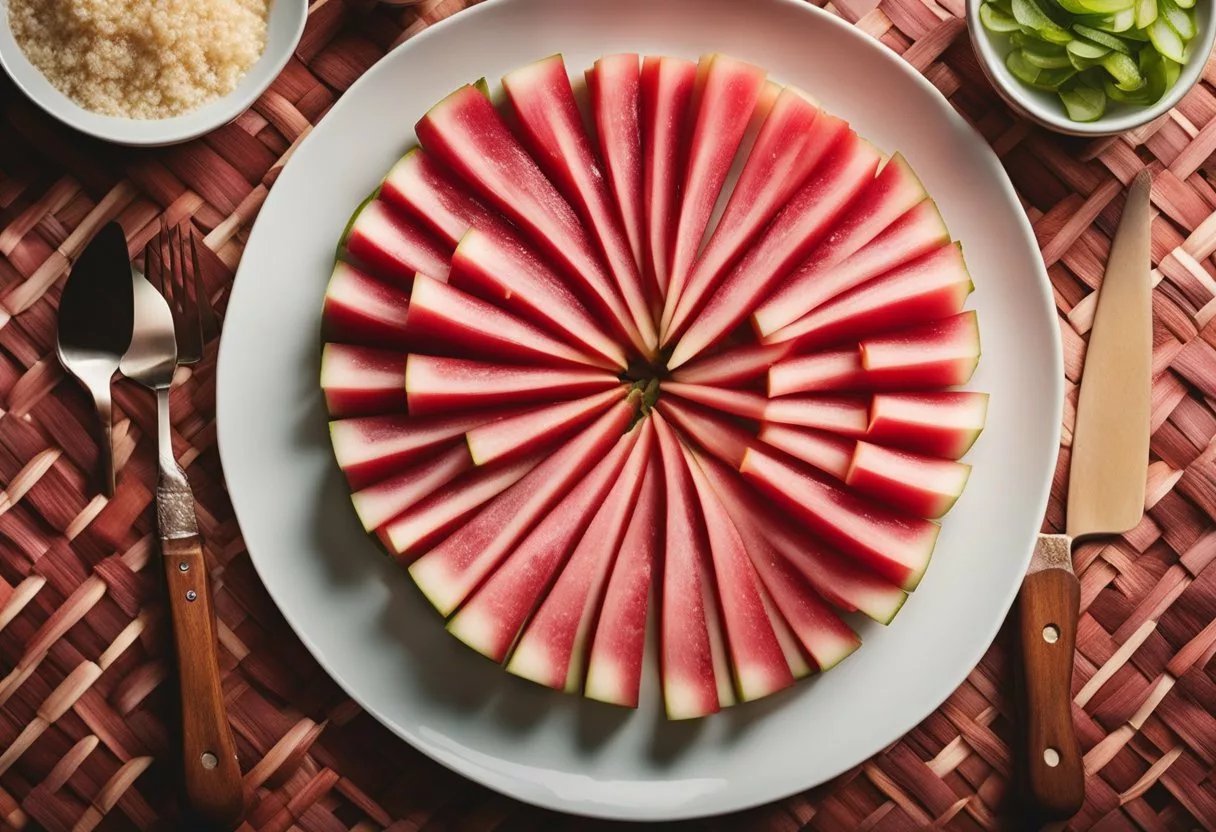
When serving rhubarb, the right accompaniments and toppings can enhance its natural tartness and can transform a simple dish into an impressive presentation.
Dish Accompaniments
Rhubarb’s unique tangy flavor makes it a versatile ingredient that pairs well with a variety of sweet and creamy bases.
For a classic approach, one might serve stewed rhubarb over vanilla ice cream or layer it with custard for a delightful contrast in flavors.
Another elegant option involves presenting rhubarb compote alongside a dollop of cream or a scoop of yogurt to balance its acidity.
- Ice Cream: Vanilla ice cream offers a sweet, creamy complement.
- Custard: The silky texture contrasts nicely with rhubarb’s slight bite.
- Yogurt: A healthy alternative, Greek yogurt particularly complements the tartness.
Topping Ideas
As a topping, rhubarb adds a pop of flavor and color that can make any dish more appealing.
It works splendidly as a topping on morning favorites like pancakes and waffles, especially when mixed with granola for added texture.
In desserts, a rhubarb reduction can be drizzled over cheesecake or panna cotta, bringing a sweet-yet-tangy dimension that elevates the final product.
Sweet: Stir in a little sugar during the cooking process to curb the tartness. Tangy: Keep the topping zesty by reducing the sweeteners.
- Granola: Offers a crunchy contrast perfect for breakfast dishes.
- Dessert Sauces: Rhubarb sauces enhance the flavors of subtle desserts.
Preserving Rhubarb
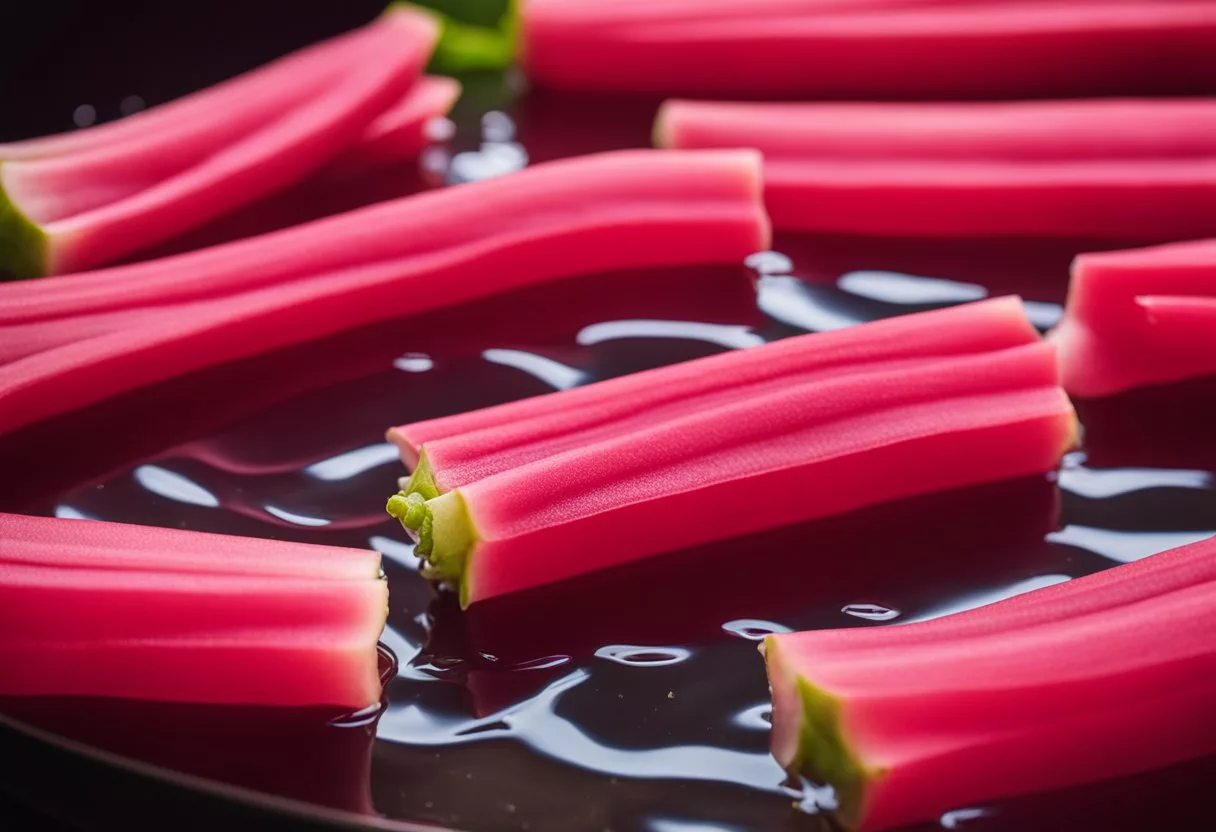
Preserving rhubarb is a straightforward process involving either canning or freezing to retain its tart flavor for long-term use. These techniques prevent spoilage and allow one to enjoy rhubarb outside its typical season.
Canning and Freezing
Canning: Canning rhubarb allows it to be stored in the pantry. The process starts with washing the stalks, trimming the ends, and cutting them into uniform pieces. The pieces are then packed into canning jars with a hot syrup made of equal parts water and sugar. The jars are processed in a boiling water bath, ensuring they are sealed properly to prevent bacteria growth.
- Hot Syrup Ratio: 1 cup water to 1 cup sugar
- Piece Size: Uniform, typically ½-inch
- Head Space: Leave a ½-inch at the top of the jar
- Boiling Time: Varies depending on jar size and altitude
Freezing: Freezing is a method ideal for preserving rhubarb’s texture and flavor. After washing and cutting the rhubarb into desired sizes, they should be arranged on a baking sheet in a single layer and frozen until solid. The pieces can then be transferred to freezer bags, removing as much air as possible before sealing.
- Pre-Freeze: Single layer on a baking sheet
- Freezer Bags: Labeled with date and contents
- Storage: In the freezer, separated into portion sizes for future use
Making Preserves
Jams and Compotes: Making preserves such as jam or compote is another way to extend rhubarb’s shelf life. These preserves can often be stored in the fridge after opening. They are made by cooking down the rhubarb with sugar and other ingredients until thick and spreadable.
- Sugar: Necessary for preserving and taste
- Pectin: Sometimes added to help set jam
- Acid: Lemon juice or a comparable acid can be added for safety and flavor
Tips and Tricks
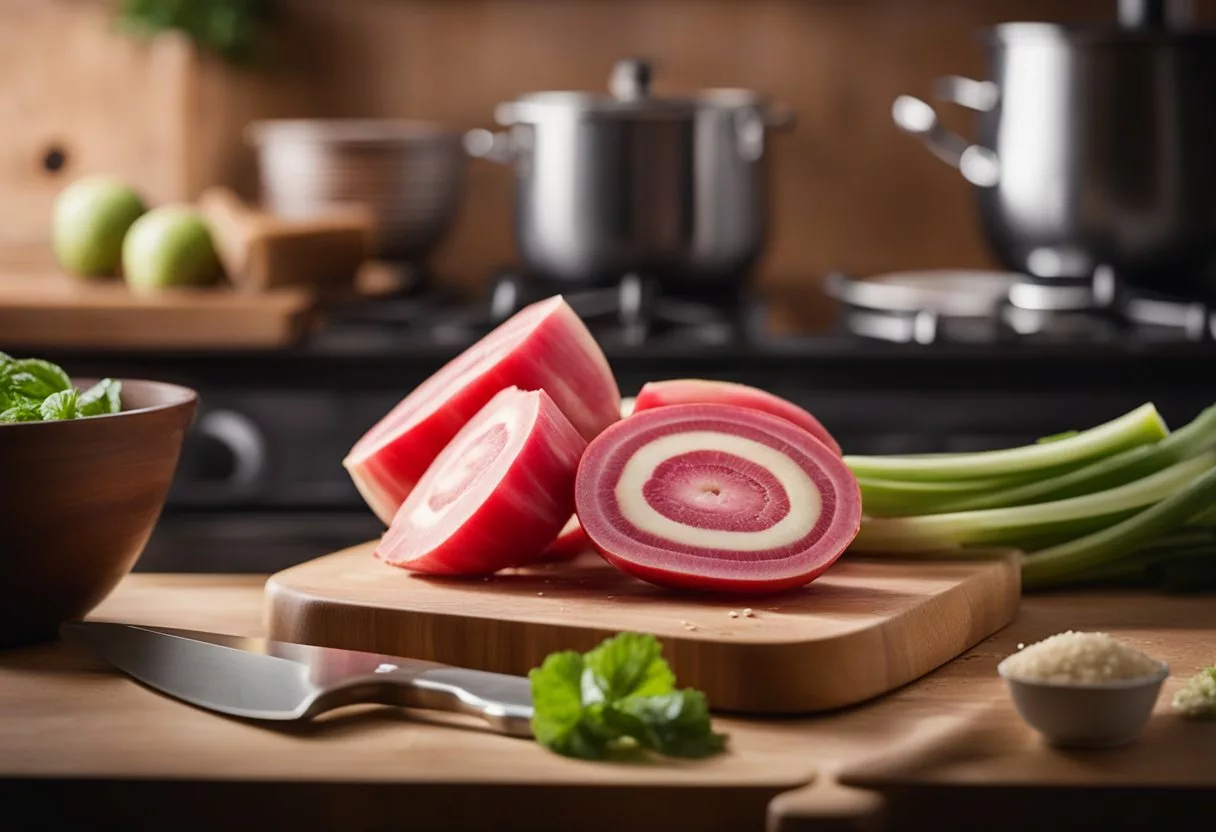
When one sets out to cook with rhubarb, they quickly discover that this tangy vegetable is versatile. With the correct preparation, it can be transformed into a delightful treat. Here are some tips and tricks that can help one navigate the process of cooking rhubarb:
Prep Tactics:
- Choose firm, crisp stalks that are bright in color.
- Rinse and slice into even pieces to ensure uniform cooking.
Sweet Balance:
- Rhubarb is inherently tangy, and pairing it with a sweetener can balance its tartness.
- Use sugar, honey, or even maple syrup according to taste preferences.
Cooking Approach:
- Roasting rhubarb enhances its natural flavors. You can find a simple roasted rhubarb recipe here.
- Slow-cooking can help retain rhubarb’s shape and texture, perfect for pies and crisps.
| Method | Temperature | Time |
|---|---|---|
| Roasting | 400℉ (204℃) | 15-20 minutes |
| Stewing | Low Heat | Until tender |
Usage Tips:
- Be mindful not to overcook it, or else it will turn to mush.
- Rhubarb pairs beautifully with strawberries in desserts for a classic combination.
In baking, they may choose to use a review technique that suggests refrigerating the rhubarb with sugar to macerate before cooking. This step draws out moisture and intensifies the flavors.
Remember: Rhubarb leaves are toxic and should never be consumed. Always discard them before cooking.
Rhubarb in Social Media
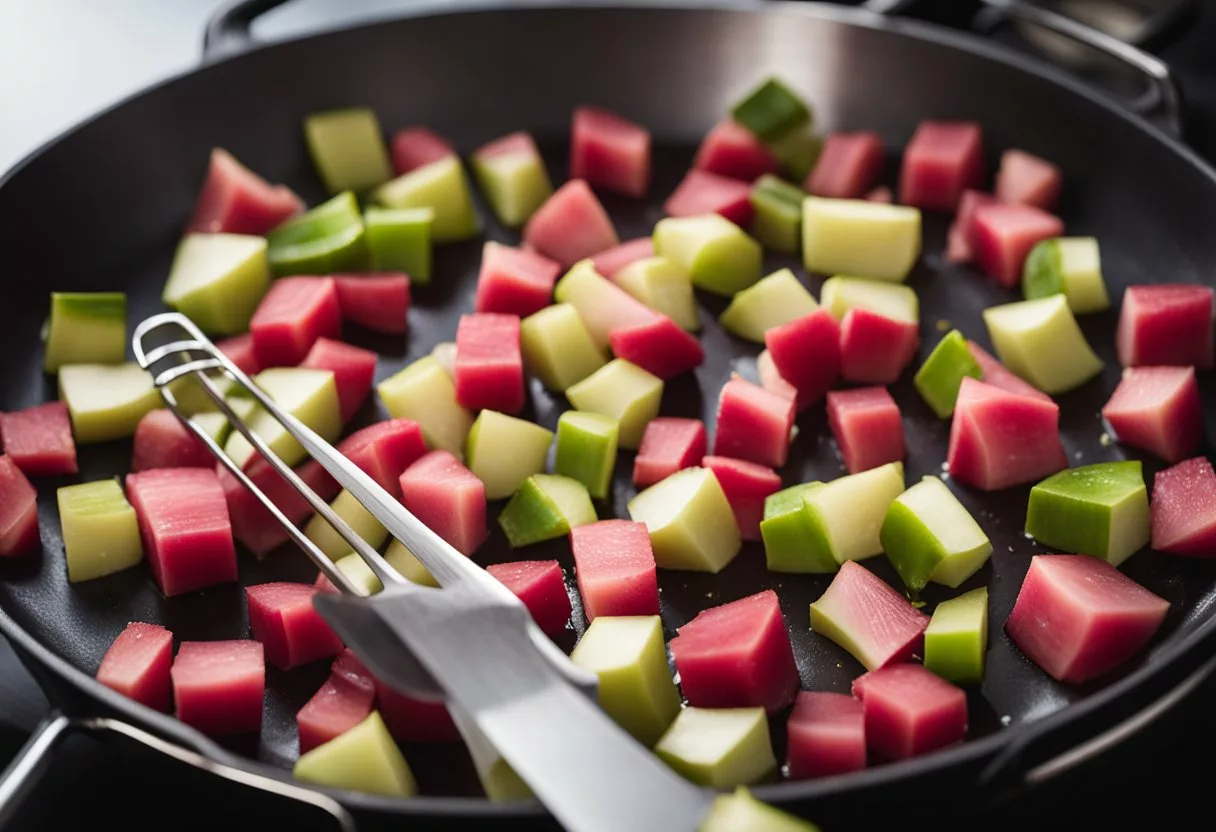
Rhubarb, a perennial vegetable often used as a fruit in cooking, has found a vivid presence on social media platforms. Particularly on Instagram, users showcase their culinary creations with hashtags like #RhubarbRecipe and #RhubarbLove. The visual allure of rhubarb, ranging from deep ruby red to light green shades, makes it particularly popular for Instagram stories and posts.
| Platform | Content Type | Popularity |
|---|---|---|
| Images and videos of rhubarb dishes | Highly engaged | |
| Tips on how to cook rhubarb | Rising interest | |
| Stories featuring rhubarb gardens | Niche communities |
Influencers and food bloggers often post images of rhubarb pies and crisps, using visually appealing plates and rustic backgrounds to enhance the aesthetics. Rhubarb’s peak season is a particularly active time on social media, with users posting timely content that aligns with its springtime harvest.
Educational content about rhubarb also performs well. Posts that share facts about its origin or tips on how to select and store rhubarb offer value to home cooks eager to utilize this versatile ingredient.
Instagram’s platform also facilitates interaction between users through features like polls in stories, where followers can vote on their favorite rhubarb dishes, or through IGTV for longer cooking demos. This interaction often leads to a broader conversation about seasonal cooking and sustainability, topics of high relevance to the platform’s food community.
Frequently Asked Questions
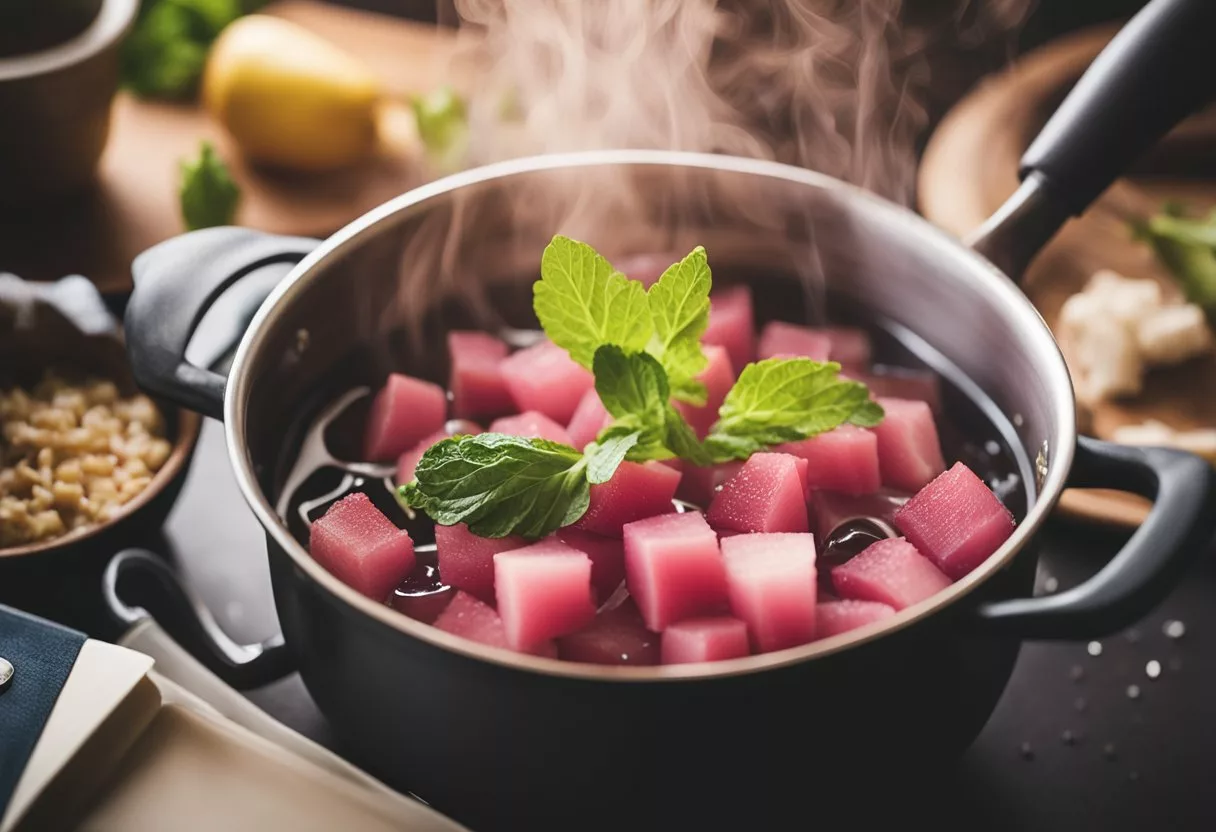
Rhubarb, a tart vegetable often used like a fruit in desserts, requires proper technique to maintain texture and flavor. This section answers common questions to ensure rhubarb is cooked perfectly.
What are the best methods to cook rhubarb without it becoming mushy?
For firm rhubarb, avoid overcooking and consider baking or roasting which allows it to hold shape better. A quick sauté can also preserve texture.
How can I cook rhubarb on the stove effectively?
To cook rhubarb on the stove, combine rhubarb, sugar, and water in a saucepan and simmer. Stir occasionally and cook until the rhubarb softens but retains some firmness.
Is it possible to cook rhubarb without adding sugar?
Yes, it is possible to cook rhubarb without sugar, though its natural tartness may be pronounced. Try using orange juice or honey as alternatives for a different flavor profile.
Can you provide tips for baking rhubarb in the oven?
For baking rhubarb, chop into uniform pieces and bake at a moderate temperature until tender yet intact. This method enhances the rhubarb’s flavor without it disintegrating.
What are the steps to prepare rhubarb for a perfect crumble?
Trim and discard the leaves, wash and slice the stalks, and mix with a thickener like cornstarch and sweetener. Layer the rhubarb beneath a crumbly topping and bake until the topping is golden and the filling is bubbling.
How can I make a simple stewed rhubarb recipe?
For simple stewed rhubarb, cut rhubarb into chunks. Then, add the chunks to a pot with a small amount of water and sugar to taste. Simmer until the fruit softens. Lastly, adjust the sweetness and cook time according to preference.